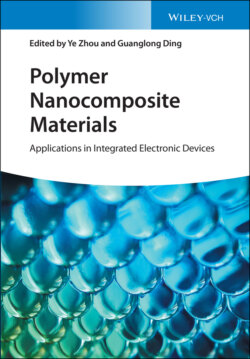Читать книгу Polymer Nanocomposite Materials - Группа авторов - Страница 31
2.2 Fabrication Methods for CPCs
ОглавлениеAs known, conductive fillers, especially nano-sized conductive particles, are easy to aggregate in the polymer due to their high-aspect-ratio, resulting in uneven distribution, which may deteriorate the comprehensive performance of CPCs [16]. Therefore, surface modification of nanofillers and special processing technique are required to enhance the dispersion of conductive nanofillers in the polymer, which mainly includes the following methods: (i) The physical blending [17]. The conductive particles are uniformly dispersed into the polymer melt matrix or polymer solution under the ultra-strong external field forces (shear, tensile, etc.). (ii) In situ polymerization [18]. The conductive particles were firstly dispersed in the organic solvent containing the polymer monomer. After the polymerization reaction, the previously evenly dispersed conductive particles were anchored in the polymer matrix in situ. (iii) Chemical modification of conductive filler [19]. After the chemical reaction, the surface of conductive particles is grafted with functional groups such as hydroxyl group, carboxyl group, amino group, etc. These groups have good interactions with the polymer, such as covalent bond and hydrogen bond, which can effectively avoid the nanofillers aggregation and hence improve their dispersion in the polymer matrix. (iv) Introduction of surfactant [20]. The surfactant will wrap around the conductive particles, increasing their compatibility in polymer solution or melt, thus improving the dispersion of the fillers.
For CPCs, the electrical conductivity is depended on the transportation of charge carriers (current) along the conductive network constructed by conductive fillers in the polymer matrix. Generally, a sudden increase of several orders of magnitude in conductivity (transition from insulator to conductor) can be found as the concentration of conducting phase reaches a critical value in the polymer matrix, which is defined as the percolation threshold. Above this threshold, the concentration dependence of the conductivity of the CPCs (σ) can be described by a scaling law
where σ0 represents the intrinsic conductivity of the fillers, t represents the electrical conductivity exponent, ϕ represents the volume fraction of conductive particles, and ϕc represents the volume fraction at percolation transition [21]. In a random conducting network, the exponent t only depends on the dimensionality of the network [22], which is called universal percolation behavior. Theoretical calculation suggests that t = 1–1.3 corresponds to two-dimensional networks, while t = 2.0 represents a three-dimensional network. The percolation threshold and electrically conductivity are affected by many factors such as nanofiller dimension and microstructure of the CPCs. For example, conductive nanofillers with a large aspect ratio (CNTs, graphene nanosheet) could form well connected conductive network, which is beneficial to a low percolation threshold in CPCs [23–25]. It is also reported that nanofiller filled CPCs exhibit better electrical and mechanical properties than CPCs incorporated with microsized fillers [26, 27]. Also, the electrically conductive behavior of CPCs has strong relationship with the structure of conductive network in the polymer matrix. The perfect interconnection between conductive nanofillers and formation of 3D continuous pathway in the polymer matrix are regarded as the key factor for construction of the conductive network [28]. As a result, the morphology and distribution of nanofiller in the polymer matrix play an important role determining the electrical conductivity of CPCs. The fabrication process and parameters can greatly influence the morphology of conductive network in polymer matrix and thus their electrical properties. There are many methods for fabrication of CPCs have been reported, among which melt blending, solution mixing and in situ polymerization are regarded as three major methods. However, it still remains challenge to prepare high performance CPCs with low percolation threshold while high conductivity [29, 30].
